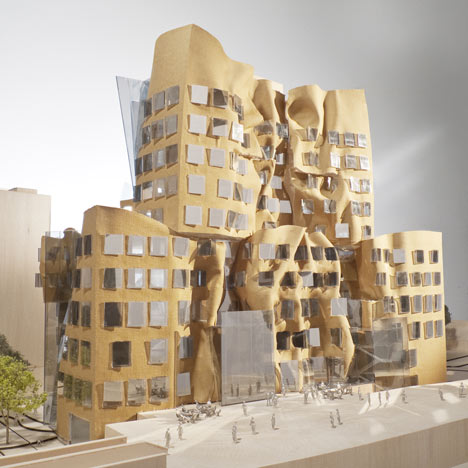
Dr Chau Chak Wing Building by Frank Gehry
Architect Frank Gehry has unveiled his designs for a new business school at the University of Technology Sydney, Australia.
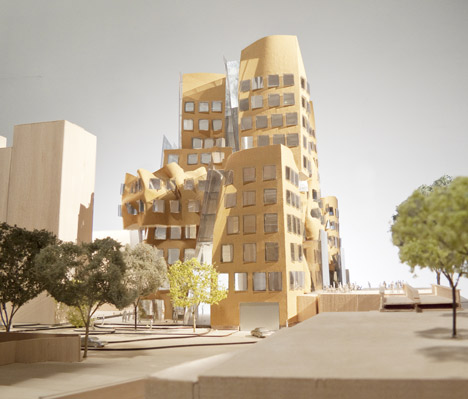
The 11-storey Dr Chau Chak Wing Building will have an undulating brick facade on one side and slices of glass over the other.
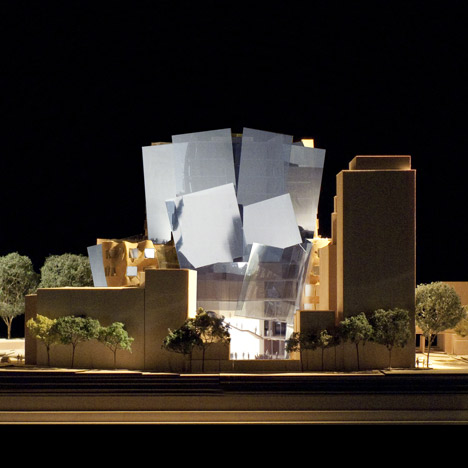
Construction is due to commence in 2012.
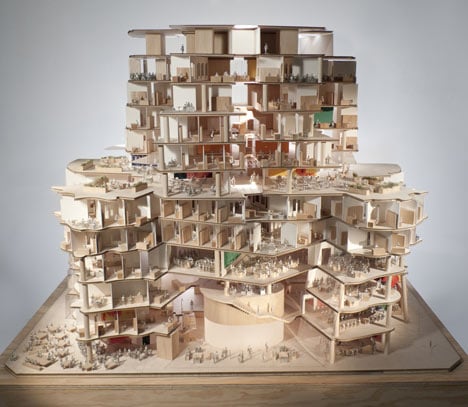
See all our stories about Frank Gehry »
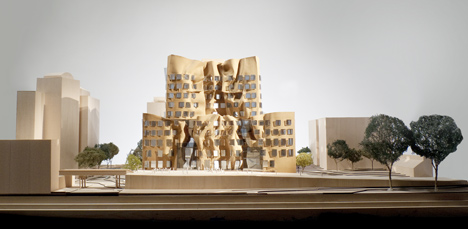
Click above for larger image
Here's some more information from the university:
Climbing the Gehry tree house to a new kind of business school
Sydney's Frank Gehry designed Dr Chau Chak Wing building will open a new page in business education in Australia.
The world-renowned architect's plans for the $150 million building, his only in Australia, were unveiled this morning at a media conference at the University of Technology, Sydney. UTS has been working with Gehry Partners to design a world-class business school based on the idea of a tree-house structure. As Frank Gehry has put it, "a trunk and core of activity and... branches for people to connect and do their private work."
The building will have two distinct external facades, one composed of undulating brick, referencing the sandstone and the dignity of Sydney’s urban brick heritage, and the other of large, angled sheets of glass to fracture and mirror the image of surrounding buildings.
The project inspired the Australian-Chinese business leader Dr Chau Chak Wing to donate a total of $25 million to UTS; $20 million to support the new building and an additional $5 million to create an endowment fund for Australia-China student scholarships. It is the equal largest ever philanthropic gift by an individual for a university in Australia.
UTS Vice-Chancellor Professor Ross Milbourne said that while the building would undoubtedly become a Sydney landmark, the key element for the University was that it was conceived from the inside out with the needs of the UTS Business School and the University at heart.
"The UTS Business School is transforming itself with an emphasis on integrative thinking – producing students with boundary crossing skills as well as specialised knowledge," Professor Milbourne said.
"From the start Gehry Partners has worked closely with the School's leadership, its academics and students to develop an environment that fosters and encourages this openness and collaboration in teaching and research, and engagement with business and the community.
"This is a building for all of Sydney. There will be extensive public spaces with an external design that complements and acknowledges its place within the immediate area and within the city.
"The project is already providing benefits for students outside the Business School, with four UTS architecture students selected for internships at Gehry Partners' studios in Los Angeles."
The 11-storey Dr Chau Chak Wing building will stand at the corner of Ultimo Road and Omnibus Lane on a site that once housed the Dairy Farmers Cooperative and is currently being used as a car park.
Professor Milbourne said some elements of the schematic design were still fluid and will be subject to some modification, pending community consultation and authority approval. Community and stakeholder consultation will take place from 17 December to 14 January.
Construction is due to start in early 2012 and be complete in time for the 2014 academic year.
The Dr Chau Chak Wing Building is part of the ten-year $1 billion UTS City Campus Masterplan, which is helping transform the southern CBD and will deliver a cutting-edge and connected campus for staff, students and the broader community.
Planning
A key component of UTS’s City Campus Master Plan, the Dr Chau Chak Wing Building will provide teaching, learning, research and office accommodation for the UTS Business School. There will be extensive public spaces in the new building, including student lounges, cafes and outdoor roof terraces.
Total project value, $150 million Total floor area 16,030 sqm, spread over 11 floors
Construction will start in early 2012 and be complete in time for the 2014 Academic year.
UTS is unveiling the schematic design of the new Dr Chau Chak Wing Building. This design will be subject to some modification, pending community consultation and authority approval.
In January 2011, UTS will undertake community and stakeholder consultation on the new design. This consultation forms part of the “Part 3A” submission that UTS will make to the NSW Depart- ment of Planning for approval of the design.
PROJECT SHEET & ARCHITECT DESIGN STATEMENT (CONT.)
City Campus Master Plan
The UTS City Campus Master Plan is a vision to deliver an iconic and connected campus that supports the university’s vision to be- come a world-leading university of technology. The Master Plan is also a ten-year $1 billion redevelopment that will help transform the southern Sydney CBD. The Master Plan will create a series of new buildings, major upgrades and improved pedestrian connections, right in the heart of Ultimo and Haymarket.
The Dr Chau Chak Wing building is the centrepiece of the $1 bil- lion City Campus Master Plan which is expected to generate an estimated $3.2 billion in NSW economic activity. 1700 jobs are ex- pected to be generated each year over the 10 year construction period. The Chau building is estimated to attract 24,000 interstate visitors and 2,000 international visitors each year, adding $36 mil- lion to the tourism industry through spending by business event visitors annually. Source: Independent modelling by Urbis.
Australian-Chinese business leader Dr Chau Chak Wing has do- nated a total of $25 million to UTS; $20 million to support the new Business School designed by Frank Gehry, and an additional $5 million to create an endowment fund for Australia-China student scholarships. The gift makes Dr Chau one of the leading philanthro- pists in the Asia-Pacific region. In recognition of the gift – the largest ever made to an Australian university – UTS Council determined to name the new Gehry-designed Business School building the Dr Chau Chak Wing Building.
The project is located on the former Dairy Farmers Cooperative site at the corner of Ultimo Road and Omnibus Lane. The site will operate as a public car park until demolition and excavation com- mences.
UTS commissioned Gehry Partners to undertake concept design of the Dr Chau Chak Wing Building in late 2009. The concept design by Gehry Partners was approved by UTS Council in June 2010.
Gehry Partners, LLP is a full service firm with broad inter- national experience in academic, commercial, museum, performance, and residential projects. Frank Gehry es- tablished his practice in Los Angeles, California in 1962. The Gehry partnership, Gehry Partners, LLP, was formed in 2001 and currently supports a staff of over 120 people.
Frank Gehry is among the world’s best known architects. His milestone projects include the Bilbao Guggenheim Museum and the Los Angeles Walt Disney Concert Hall. Every project under- taken by Gehry Partners is designed personally and directly by Frank Gehry.
Local team Builder
A local consultant team – comprising Australian architects Daryl Jackson Robin Dyke, engineers and other specialist disciplines – has been appointed to work alongside Gehry Partners.
UTS will engage a building contractor early on in the design pro- cess to work collaboratively with Gehry Partners and the consult- ant team. This collaboration will ensure the buildability and timely delivery of the new building. UTS is currently shortlisting builders to tender for the construction of this project.
Ultimo Pedestrian Network (UPN)
Sustainability
The Sydney Harbour Foreshore Authority is currently developing options for a revitalisation of the UPN that will create pedestrian linkages from Central Station through to Darling Harbour. Pedes- trians will be able to access the building from both Ultimo Road and a revitalised UPN
The Master Plan is integral to UTS achieving its greenhouse gas emission reduction targets and a variety of holistic sustainability goals. As one of the new buildings proposed by the Master Plan, UTS and Gehry Partners intend to seek a 5-Star Green Star Edu- cational Building Rating for the Dr Chau Chak Wing Building.
Key sustainability measures currently being investigated by UTS and the project team include: low carbon emissions, achieved through low-energy air conditioning and lighting, and tri-gener- ation power supply; smart air conditioning, designed to switch off when offices are empty for an extended period of time; monitoring of CO2 levels within the building; intelligent lighting that adjusts according to natural light levels; optimising natural light, includ- ing window positions, floor plate design and window glazing; and, rainwater capture and storage for use in cooling towers and toilet flush applications.
Site context
The University of Technology, Sydney (UTS) Dr Chau Chak Wing Building will be a 16,030 square metre academic building that will replace the current home of the Business School in the Hay- market Building. It will contain teaching and learning spaces, re- search spaces, and faculty offices, as well as support facilities including a publicly accessible café. Parking for 28 cars will be in a basement level along with bicycle parking and shower rooms for students and staff who choose to cycle to the school. It will be located on the Dairy Farmers building site at the corner of Ultimo Road and Omnibus Lane. The 2,816 square meter site is bounded on the north by Mary Ann Street and on the east by the Ultimo Pedestrian Network (UPN).
UTS is an urban campus with buildings integrated into Sydney’s Ultimo neighborhood. It is not a traditional campus with clearly defined boundaries. This integration suits the goals of the Busi- ness School to reach out to the surrounding community and to connect with local businesses. The site for the new building is not a part of the main UTS campus, but rather is to be one of the outlying buildings that are a part of the campus expansion toward Darling Harbor to the north. It is surrounded by buildings that are not a part of the University: the Australian Broadcasting Corpora- tion (ABC) headquarters to the south, an apartment building and a Sydney TAFE building to the west, and the Powerhouse Museum to the north. This very tight urban site offers an exciting architec- tural context and the opportunity to respond to the diverse colors, scales, and textures of the neighborhood buildings.
The site will be accessed from the main campus by two primary routes: one on the street level via Harris Street to an entry on Ultimo Road, and a second via a bridge across Harris Street con- necting to the UPN and then north to a second level entry directly off the UPN. The UPN will also be the primary route for visitors coming from Central Station. The below grade parking will be ac- cessed by ramp from a mid block driveway on Ultimo Road. Ser- vice access will be from the basement garage level, which will accommodate van deliveries.
A portion of the teaching space for the Faculty of Business will be located in renovated space in the Haymarket Building to the east. A pedestrian bridge is proposed from the new building across the UPN, over Darling Drive, and connecting to an upper level of the Haymarket Building. This bridge is not a part of the scope of this project.
There has been discussion of creating a plaza to the north of the building on the portion of Mary Ann Street that terminates at the UPN. The Powerhouse Museum would also front on this plaza. An informal amphitheater could host outdoor performances on the east end of the plaza and act as a grand scale stairway up onto the UPN.
The concept design stays within a 10% exception to the 42 meter height limit for the Dairy Farmers parcel. The form of the design steps back from the north and south site boundaries as suggest- ed in the design guidelines, giving solar access and views to the sky for the adjacent streets and buildings. The height of the build- ing will give it presence in the neighborhood and visibility from the UTS Tower.
Accommodations and functional relationships
The schedule of accommodation calls for 10,206 net square me- ters of space with 18 teaching spaces and classrooms, and 526 positions for research and faculty work divided between enclosed offices, open office workstations, and unassigned workstations called “hot desks.”
The ground floor of the building will have a café with seated din- ing that opens to additional outdoor tables on the sidewalk and proposed plaza to the north. A coffee bar with outdoor seating will animate the upper level entry off the UPN, conveniently adjacent to the student center and the large student lounge. Connected via a staircase to the student lounge will be a more secluded gradu- ate student lounge one level above. An event and gallery space will be located on the ground floor facing Omnibus Lane to be used for the school’s outreach functions, lectures, and exhibits related to the work of the school. Situated in this event and gallery space will be two stacking oval-shaped classrooms with tiered seating. The lower classroom will be able to open to the social space for large events that require additional seating.
A 240 seat auditorium is located adjacent to the northern ground floor entry. This will be a venue for public lectures, panel discus- sions and debates. It will have an extensive audio/visual system and video conferencing. Event check-in and informal receptions will take place in the lobby space outside this room.
The teaching and learning spaces, which are accessibly located on the lower four levels of the building, are comprised of various classroom types primarily serving postgraduate students. There are 10 graduate seminar rooms of 40 seats with flat floors to al- low for flexibility in seating arrangement, a 120 seat bowl class- room with desk seating and loose chairs on the first floor, 4 flat floor graduate computer labs for 40 students each, and 2 oval classrooms for 60. The 120 seat bowl classroom is stepped 2 rows at a time to allow students in the front row of each step to turn around and join the students behind them in casual group discussions. In addition to these larger spaces there are 10 group study rooms, 4 of which will accommodate 8 and 6 of which will accommodate 4.
The 6th floor of the building is configured for short course execu- tive education seminars. Management professionals from out- side the university will participate in these courses as a part of the school’s goal to engage with local industry. On this floor there are 2 seminar rooms that will accommodate up to 60 participants with a breakout space where coffee and lunches will be served. A catering space will support this use. Also on the 6th floor is a re- search seminar room for 40. Each of these rooms opens directly onto a roof terrace anticipating breakout sessions and group dis- cussions outdoors in pleasant weather. The faculty room is also located on the 6th floor to take advantage of another roof terrace.
The upper levels of the building, which are primarily devoted to research and academic spaces, are configured to promote cross- disciplinary exchange. Open floor areas connect clusters of re- search and faculty offices. Lounge furniture and informal meet- ing spaces are integrated into each of these floors. The top floor accommodates a boardroom serviced by a pantry, adjacent to a large function area with a bar, both with views to Sydney Harbour, designed for hosting private University events.
Building organisation
The conceptual organization of the design follows a conversa- tion between Frank Gehry and Roy Green as the project began. Frank imagined a building that was a cluster of “tree houses,” or vertical stacks of office floors with spatial “cracks” in between. He made a sketch of this idea on a napkin and gave it to Roy. Working groups would feel an intimacy with others working within their own tree house while looking across the cracks to other tree houses. Groups would be curious to know what was going on in an adjacent tree house and would go across to find out. This would be a way to create focused space for research while at the same time encouraging cross-disciplinary exchange. This interrelation- ship is one of the main goals of the school and is promoted by the configuration of the building.
The current design incorporates this idea. Each of the larger low- er floors is divided into six floor segments. The building façade folds in between these elements bringing natural daylight deep into the center of the floors. This divides what would otherwise be a very large, corporate-type office floor of 1,800 square meters into smaller areas in which each individual would have an impor- tant identity. The upper floors have been divided into four sections with the same intent. The Gehry team has worked with the Business School to test the design to determine if the size and scale of the plan units fit with the size of research groups and fac- ulty clusters. Many iterations of the plan organization have been laid out, and the latest version is contained in this document. In parallel, the Business School is going through a reorganization of its research and teaching structure as the design proceeds. It is a rare collaborative opportunity to be able to design a building and an organizational structure simultaneously.
Architectural design
In the Concept Design phase the design team focused on a care- ful analysis of the Schedule of Accommodation and has spent time with the Business School getting to know the goals and ob- jectives of the teaching, research, and industry engagement that are at the heart of the school’s mission. This knowledge has in- formed many iterations of the design, studying the building from the inside out. The urban issues of building siting, access, mass- ing, and height have shaped the building design within its context. The Gehry Partners process values the resolution of these most important functional and social aspects of any project, and the architectural expression evolves very slowly from a deep under- standing of these issues.
The building façade has been explored through several design it- erations. A variety of materials were studied. Each of the designs was evaluated in relation to the project budget; the current design fits within the budget. Window locations have been considered to bring light into all of the teaching spaces and to bring the maxi- mum amount of daylight into work spaces throughout the build- ing. Gehry Partners has run computer sun studies to understand the light and shadow relationships to the adjacent sites and to spaces within the building. The current design places large areas of glass at the street level to promote transparency and to create a welcoming body language for the building. The work spaces themselves have large windows punched through areas of solid façade. The proportion and spacing of these windows has been studied in relation to office modules in order to provide as much flexibility as possible for the future evolution of uses.
The façade of the building will have 2 aspects and 2 different personalities. The east facing façade that contains an entry from the UPN is made of a buff colored brick similar in color to the Sydney Sandstone. The form of this façade curves and folds like soft fabric. The brick will be set in horizontal courses and will step or corbel to create the shape. The texture of the surface will be rough and will emphasize the mass of the material. The shape flattens as it wraps around the north and south corners. Large windows punch this façade. The west facing façade that contains the ground level entry off Ultimo Road is composed of large shards of glass façade. This glass will be slightly reflec- tive to fracture and mirror the image of the surrounding buildings of the neighborhood. Sculptural brick towers will stand at the northwest and southwest corners of this facade.
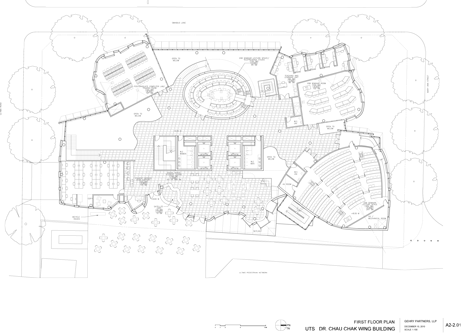
Click above for larger image
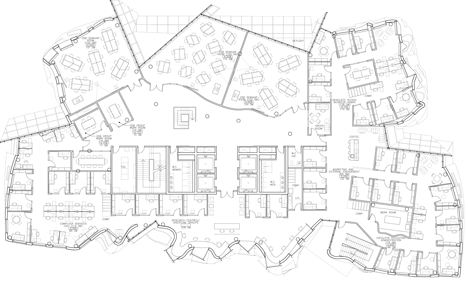
Click above for larger image
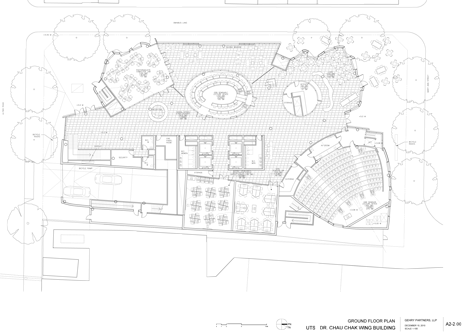
Click above for larger image
See also:
.
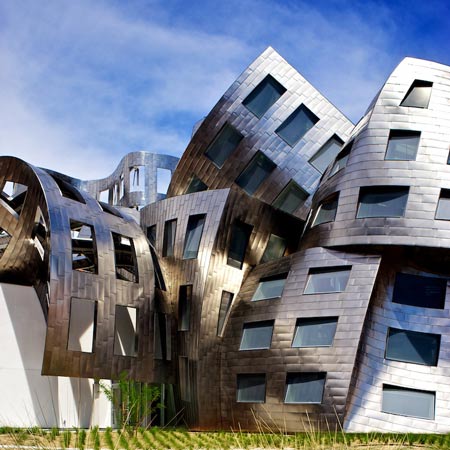 |
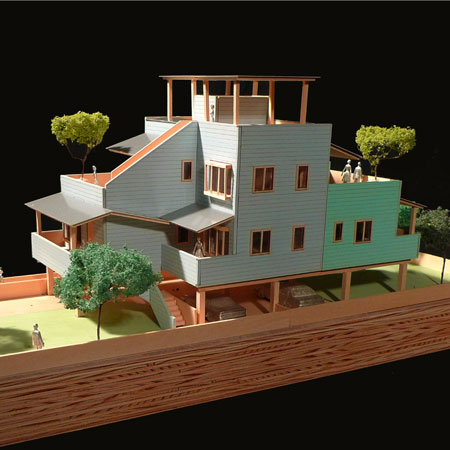 |
|
| Lou Ruvo Center for Brain Health by Frank Gehry | Duplex by Frank Gehry for Make it Right |
More stories about education |